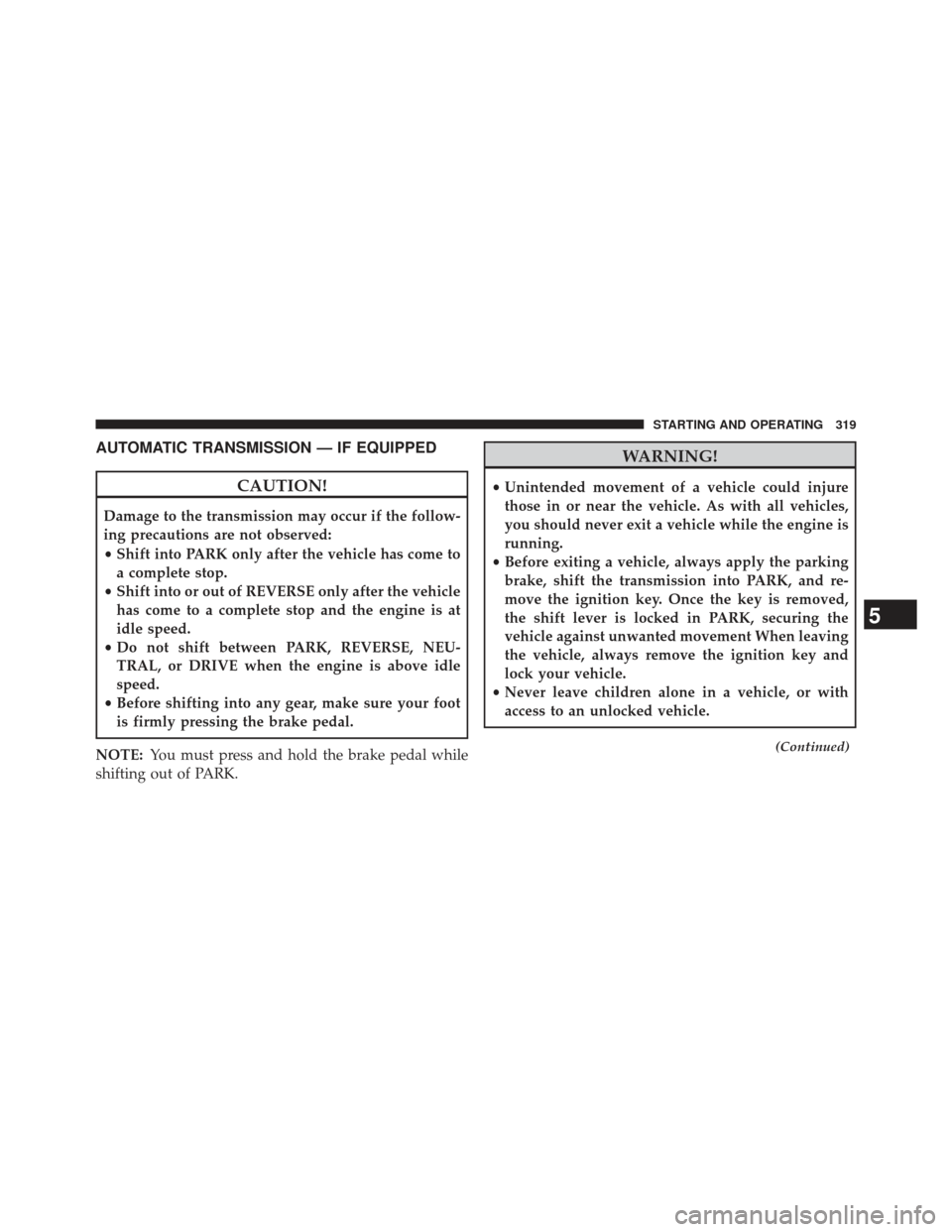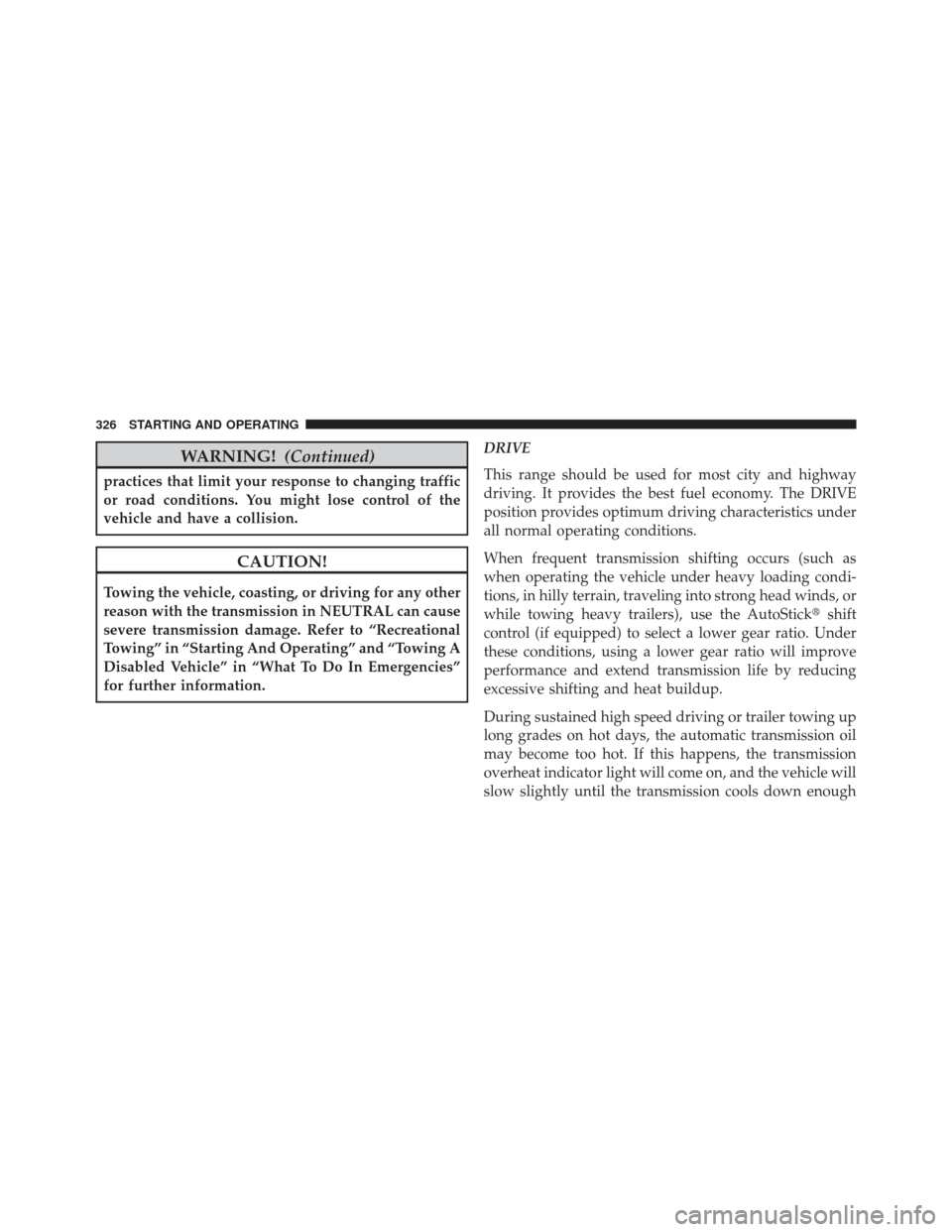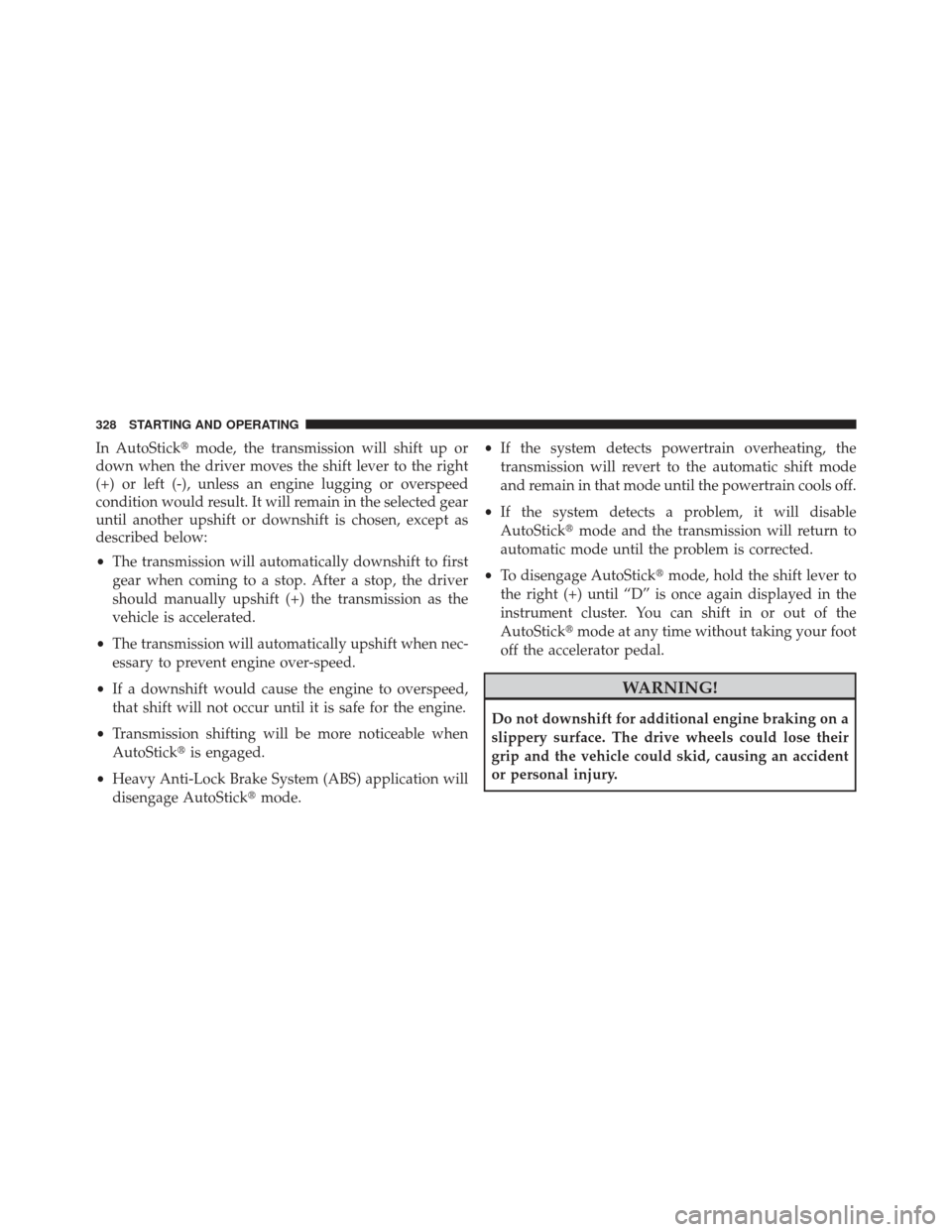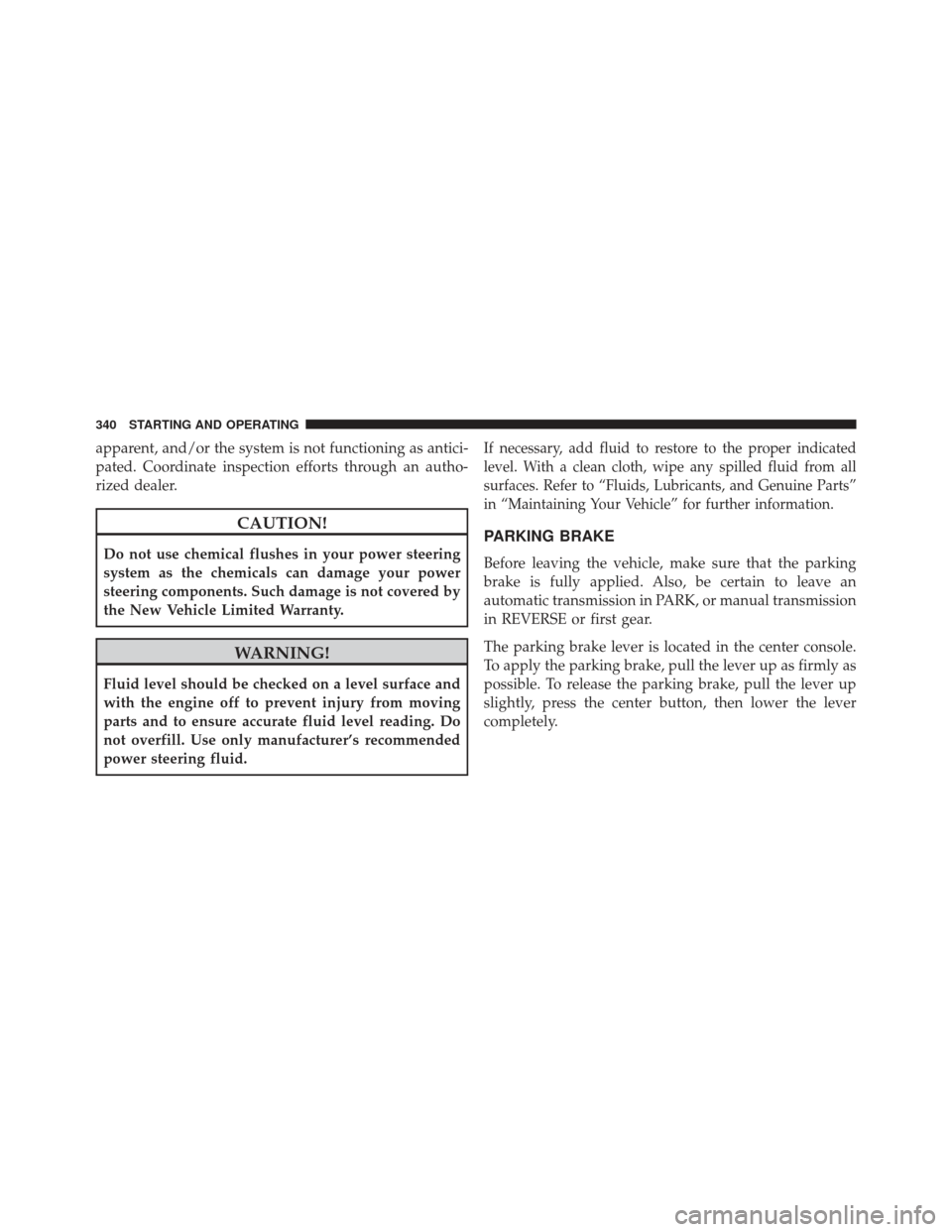Page 311 of 525
STARTING AND OPERATING
CONTENTS
�STARTING PROCEDURES ................313
▫ Manual Transmission – If Equipped ........313
▫ Automatic Transmission – If Equipped ......314
▫ Normal Starting ...................... .314
▫
Extreme Cold Weather (Below –20°F Or �29°C) . .315
▫ If Engine Fails To Start ..................315
▫ After Starting ....................... .315
� ENGINE BLOCK HEATER — IF EQUIPPED . . .316
�
MANUAL TRANSMISSION — IF EQUIPPED . . .316
▫ Five–Speed Manual Transmission ..........316▫
Recommended Shift Speeds ..............318
▫ Downshifting ....................... .318
� AUTOMATIC TRANSMISSION —
IF EQUIPPED ......................... .319
▫ Key Ignition Park Interlock ...............320
▫ Brake/Transmission Shift Interlock System . . .320
▫ Continuously Variable Automatic
Transmission (CVT) ....................321
� AUTOSTICK� ........................ .327
▫ Continuously Variable Automatic
Transmission (CVT) ....................327
5
Page 316 of 525

Automatic Transmission – If Equipped
The shift lever must be in the PARK or NEUTRAL
position before you can start the engine. Apply the brakes
before shifting to any driving gear.
NOTE:You must press the brake pedal before shifting
out of PARK.
Tip Start
Do not press the accelerator. Turn the ignition switch to
the START position and release it as soon as the starter
engages. The starter motor will continue to run, and it
will disengage automatically when the engine is running.
If the engine fails to start, the starter will disengage
automatically in 10 seconds. If this occurs, turn the
ignition switch to the LOCK position, wait 10 to 15 sec-
onds, then repeat the “Normal Starting” procedure.
Normal Starting
Normal starting of either a cold or a warm engine does
not require pumping or pressing the accelerator pedal.
Simply turn the ignition switch to the START position
and release when the engine starts. If the engine fails to
start within 15 seconds, turn the ignition switch to the
OFF position, wait 10 to 15 seconds, then repeat the
“Normal Starting” procedure.
WARNING!
Do not attempt to push or tow your vehicle to get it
started. Vehicles equipped with an automatic trans-
mission cannot be started this way. Unburned fuel
could enter the catalytic converter and once the
engine has started, ignite and damage the converter
and vehicle. If the vehicle has a discharged battery,
booster cables may be used to obtain a start from
(Continued)
314 STARTING AND OPERATING
Page 321 of 525

AUTOMATIC TRANSMISSION — IF EQUIPPED
CAUTION!
Damage to the transmission may occur if the follow-
ing precautions are not observed:
•Shift into PARK only after the vehicle has come to
a complete stop.
• Shift into or out of REVERSE only after the vehicle
has come to a complete stop and the engine is at
idle speed.
• Do not shift between PARK, REVERSE, NEU-
TRAL, or DRIVE when the engine is above idle
speed.
• Before shifting into any gear, make sure your foot
is firmly pressing the brake pedal.
NOTE: You must press and hold the brake pedal while
shifting out of PARK.
WARNING!
• Unintended movement of a vehicle could injure
those in or near the vehicle. As with all vehicles,
you should never exit a vehicle while the engine is
running.
• Before exiting a vehicle, always apply the parking
brake, shift the transmission into PARK, and re-
move the ignition key. Once the key is removed,
the shift lever is locked in PARK, securing the
vehicle against unwanted movement When leaving
the vehicle, always remove the ignition key and
lock your vehicle.
• Never leave children alone in a vehicle, or with
access to an unlocked vehicle.
(Continued)
5
STARTING AND OPERATING 319
Page 323 of 525

of PARK, the ignition switch must be turned to the
ON/RUN position (engine running or not) and the brake
pedal must be pressed.
Continuously Variable Automatic Transmission
(CVT)
The shift lever position display (located in the instrument
cluster) indicates the transmission gear range. You must
press the brake pedal to move the shift lever out of PARK
(refer to “Brake/Transmission Shift Interlock System” in
this section). To drive, move the shift lever from PARK or
NEUTRAL to the DRIVE position.
NOTE:The Continuously Variable Automatic Transmis-
sion (CVT) changes ratios in a continuous manner. This
may sometimes �feel�as if it is slipping, but this is normal
and does not harm anything. Only shift from DRIVE to PARK or REVERSE when the
accelerator pedal is released and the vehicle is stopped.
Be sure to keep your foot on the brake pedal when
shifting the transmission between these gears.
The transmission shift lever has PARK, REVERSE, NEU-
TRAL, and DRIVE shift positions. Manual shifts can be
made using the AutoStick�
shift control (refer to
“AutoStick�” in this section). Moving the shift lever to
the left or right (-/+) while in the DRIVE position will
manually select from a set of predefined transmission
gear ratios, and will display the current gear in the
instrument cluster as 6, 5, 4, 3, 2, 1.
5
STARTING AND OPERATING 321
Page 328 of 525

WARNING!(Continued)
practices that limit your response to changing traffic
or road conditions. You might lose control of the
vehicle and have a collision.
CAUTION!
Towing the vehicle, coasting, or driving for any other
reason with the transmission in NEUTRAL can cause
severe transmission damage. Refer to “Recreational
Towing” in “Starting And Operating” and “Towing A
Disabled Vehicle” in “What To Do In Emergencies”
for further information. DRIVE
This range should be used for most city and highway
driving. It provides the best fuel economy. The DRIVE
position provides optimum driving characteristics under
all normal operating conditions.
When frequent transmission shifting occurs (such as
when operating the vehicle under heavy loading condi-
tions, in hilly terrain, traveling into strong head winds, or
while towing heavy trailers), use the AutoStick
�shift
control (if equipped) to select a lower gear ratio. Under
these conditions, using a lower gear ratio will improve
performance and extend transmission life by reducing
excessive shifting and heat buildup.
During sustained high speed driving or trailer towing up
long grades on hot days, the automatic transmission oil
may become too hot. If this happens, the transmission
overheat indicator light will come on, and the vehicle will
slow slightly until the transmission cools down enough
326 STARTING AND OPERATING
Page 329 of 525

to allow a return to the requested speed. This is done to
prevent transmission damage due to overheating. If the
high speed is maintained, the overheating may reoccur,
as before, in a cyclic fashion.
LOW – IF EQUIPPED
This range should be used for engine braking when
descending very steep grades. In this range, the trans-
mission will downshift for maximum engine braking,
and upshifts will occur only to prevent engine overspeed.
AUTOSTICK�
Continuously Variable Automatic Transmission
(CVT)
AutoStick�is a driver-interactive transmission feature
providing six manually selectable gear ratios, giving you
more control of the vehicle. AutoStick� allows you to
maximize engine braking, eliminate undesirable upshifts and downshifts, and improve overall vehicle perfor-
mance. This system can also provide you with more
control during passing, city driving, cold slippery condi-
tions, mountain driving, trailer towing, and many other
situations.
Operation
NOTE:
AutoStick� is not available until the CVT warms
up in cold weather.
When the shift lever is in the DRIVE position, AutoStick �
is activated by moving the shift lever side-to-side. Mov-
ing the shift lever to the right (+) will activate AutoStick �
and shift up to the next higher manual ratio, unless you
are already operating in or near Overdrive, in which case
sixth gear ratio will be selected. In like manner, moving
the shift lever to the left (-) will activate AutoStick� and
shift to the next lower manual ratio. The manually-
selected gear will be displayed in the instrument cluster.
5
STARTING AND OPERATING 327
Page 330 of 525

In AutoStick�mode, the transmission will shift up or
down when the driver moves the shift lever to the right
(+) or left (-), unless an engine lugging or overspeed
condition would result. It will remain in the selected gear
until another upshift or downshift is chosen, except as
described below:
• The transmission will automatically downshift to first
gear when coming to a stop. After a stop, the driver
should manually upshift (+) the transmission as the
vehicle is accelerated.
• The transmission will automatically upshift when nec-
essary to prevent engine over-speed.
• If a downshift would cause the engine to overspeed,
that shift will not occur until it is safe for the engine.
• Transmission shifting will be more noticeable when
AutoStick� is engaged.
• Heavy Anti-Lock Brake System (ABS) application will
disengage AutoStick� mode. •
If the system detects powertrain overheating, the
transmission will revert to the automatic shift mode
and remain in that mode until the powertrain cools off.
• If the system detects a problem, it will disable
AutoStick� mode and the transmission will return to
automatic mode until the problem is corrected.
• To disengage AutoStick� mode, hold the shift lever to
the right (+) until “D” is once again displayed in the
instrument cluster. You can shift in or out of the
AutoStick� mode at any time without taking your foot
off the accelerator pedal.
WARNING!
Do not downshift for additional engine braking on a
slippery surface. The drive wheels could lose their
grip and the vehicle could skid, causing an accident
or personal injury.
328 STARTING AND OPERATING
Page 342 of 525

apparent, and/or the system is not functioning as antici-
pated. Coordinate inspection efforts through an autho-
rized dealer.
CAUTION!
Do not use chemical flushes in your power steering
system as the chemicals can damage your power
steering components. Such damage is not covered by
the New Vehicle Limited Warranty.
WARNING!
Fluid level should be checked on a level surface and
with the engine off to prevent injury from moving
parts and to ensure accurate fluid level reading. Do
not overfill. Use only manufacturer’s recommended
power steering fluid.
If necessary, add fluid to restore to the proper indicated
level. With a clean cloth, wipe any spilled fluid from all
surfaces. Refer to “Fluids, Lubricants, and Genuine Parts”
in “Maintaining Your Vehicle” for further information.
PARKING BRAKE
Before leaving the vehicle, make sure that the parking
brake is fully applied. Also, be certain to leave an
automatic transmission in PARK, or manual transmission
in REVERSE or first gear.
The parking brake lever is located in the center console.
To apply the parking brake, pull the lever up as firmly as
possible. To release the parking brake, pull the lever up
slightly, press the center button, then lower the lever
completely.
340 STARTING AND OPERATING